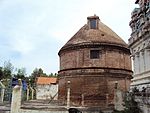Granary facts for kids

A granary is a building or room (usually in a barn) that holds grain. It keeps the grain dry so it does not spoil, and keeps it away from animals that would eat it. They are an important part of a farm. If the grain is lost, eaten by pests, or ruined, the farmers might starve or lose much money.
Contents
History
Granaries have been around as long as humans have had agriculture and in some cases even before we planted crops. The earliest ones are over 11,000 years old and stored grains that grew in the wild and were collected by hand. Granaries are still used today. It is still in a good condition .
Structure
Granaries usually have few, if any, windows. They are often built off the ground, to keep out water and mice. They will have a door near the bottom to get the grain out, and usually have an opening up high to put the grain in.
Related pages
Images for kids
-
A simple granary (early 19th century), Slovenia
-
Ancient Greek geometric art box in the shape of granaries, 850 BC. On display in the Ancient Agora Museum in Athens, housed in the Stoa of Attalos.
-
Granary model, Han dynasty
-
Han dynasty granary on Silk Road west of Dunhuang
-
Meiji period granary, Setagaya, Tokyo
-
Two rangkiang in a photo circa 1895 of rice granaries in the Minangkabau architectural style in Batipuh in the Padang Plateau, Sumatra
-
A granary sitting on staddle stones, at the Somerset Rural Life Museum
-
Multi-storey granary with portico, built in 1835, Kiszombor, Hungary.
See also
 In Spanish: Granero para niños
In Spanish: Granero para niños












